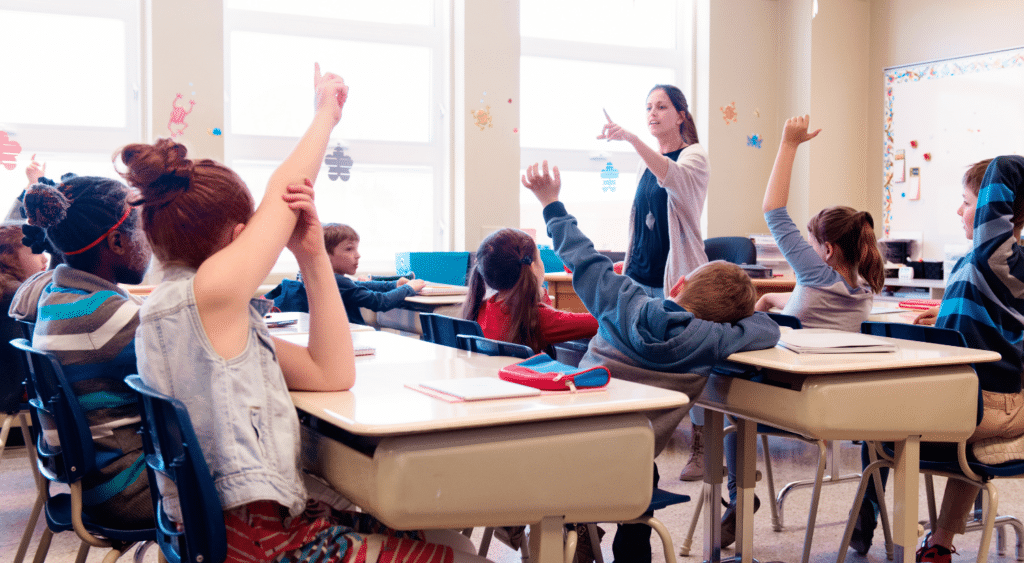How to set expectations for student behavior when substitute teaching.

Students at all grade levels have preconceived ideas about what it’s like to have a substitute teacher. Often, students think classroom routines will differ when their regular teacher is absent. One blog calls it the Substitute Teacher Effect which causes student behavior to change.
Occasionally, a student tries to take advantage of a new face in the classroom. It’s more the exception to the rule. However, as a substitute teacher, it’s important to set expectations from the start of each class—every time. It’s just good classroom management.
Classroom management strategies.
Classroom management refers to a substitute teacher’s techniques for maintaining structure, learning, and positive attitudes and behaviors. It involves using strategies to keep students on track, engage in the material, progress toward their academic goals, and help the class stay organized with assigned lessons and activities.
Below are classroom management tools for substitute teachers to take control of the class early and prevent behavior changes that are not conducive to a learning environment.
Rediscover classroom rules.
The teacher likely reviewed the classroom rules at the beginning of the school year, but some students may not think to apply the regular rules when a substitute teacher arrives. Reinforce classroom rules by discussing them at the beginning of the day. Remind them that the rules do not change just because you are the substitute teacher. Set clear expectations and explain them, so that all students easily understand them.
Be prepared.
Substitute teaching requires preparation. Preparation means knowing the class schedule and being prepared with options if you run out of time or finish an activity early. Look for classroom rules or a class behavior point system. Ask if the school has a Whole School Positive Behavior System, where they use a word and make the behavior expectations fit that word. Like Be a STAR! where the S stands for “Student who cares” and the T stands for “Timely”, etc.
Be a great communicator.
One of the best ways to ensure your classroom runs smoothly is to be an effective communicator. Communicating with students is different than communicating with your peers.
- Use age-appropriate words and sentence structures to match the age and grade of the students.
- Don’t just repeat directions. Provide instructions in various modalities – writing, verbal, even in silly songs or phrases – to ensure that all students have a good way to understand.
- Use a calm tone, even if you are feeling frustrated. If you stay calm, students will too.
- Praise and efforts of students. Remember, you are not praising the student, you are acknowledging the effort or action. That is what motivates them.
- Body language is a form of communication. Don’t stay behind the desk all day. Instead, move around the classroom and actively observe and monitor student actions and engagement.
- Always actively listen, help students think through questions, then offer constructive suggestions.
Get students attention.
You don’t want to be the substitute teacher who gets the reputation for having a noisy class. When students arrive in your room or work in groups, the noise level can rise. It’s your job to manage this without raising your voice.
There are many attention getters that seasoned educators use.
- Visual signals: turning off the lights
- Auditory signals: counting down from five
- Kinesthetic signals: students physically respond to your action — put hand on head or clap in a pattern
You may want to practice your attention getting strategy until everyone in the class understands. See this article for more ideas.
Address positive and negative student behaviors.
Positive reinforcement is a powerful way to influence behaviors in the classroom. Inform the class that they can do things to earn rewards for positive behaviors. Rewards can range from writing a note to their teacher to giving stickers or adding free time at the end of an activity.
No matter how many positive rewards you give, there will likely be times when you must deal with interruptions. Remember to be consistent and fair. Otherwise, you may notice that managing the classroom becomes more difficult. Consistency shows you are fair and that you do not have favorites.
Get to know the students.
Take some time to connect with students. It’s important to create a rapport with students, even if you are only there for one day.
Building relationships, even on a surface level, creates a connection, a bond that leads to trust and respect. This is beneficial when you ask students to engage in learning activities.
Learn student names and create opportunities to call them by their names. Learn more about them, such as their hobbies, pets, favorite music or movies, or likes and dislikes. Avoid oversharing information about yourself but let them know if you have something in common.
Keep the students engaged.
Too much downtime, finishing an activity early, or waiting for the teacher to begin the lesson can be opportunities for behavior shifts.
When substitute teaching, prepare for these moments by having backup plans and activities for inactive times. You may pass out worksheets to students who finish an activity much earlier than others. You may allow students to listen to music with headphones, play an educational game on the computer, or spend time drawing or crafting. We have many more ideas for all grade levels in this backup plans article.
Use students as assistants.
Allowing students to assist you with classroom chores can decrease the number of interruptions throughout the day. Give students specific daily jobs, like running classroom errands, handing out and collecting papers, writing on the smart board, helping with lunch duty, and more.
Students will feel valued, respected, and appreciated.
Ask for help from your neighbors.
Don’t be afraid to ask for advice about student behavior management from other teachers. They know the students and likely have seen the regular classroom teacher use effective techniques.
They can share what works and what doesn’t work for their classrooms. Most teachers want to help. Since you now know their best strategy, they may even remember and request you the next time they take a day off.
Grow as a substitute teacher with Kelly Education.
If you or someone you know is interested in substitute teaching jobs, fill out our brief interest form, and one of our recruiters will contact you to answer your questions.
View Related: Article Workplace culture
You might like
Find your next job
Discover thousands of temporary, full-time, and remote jobs for beginning and experienced job seekers.



